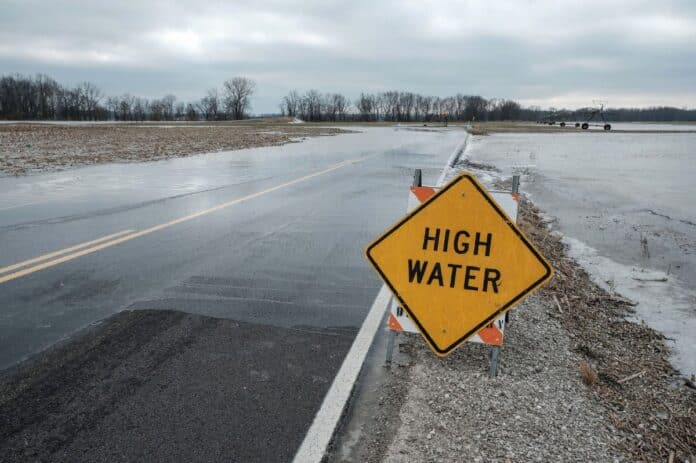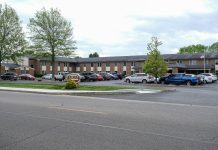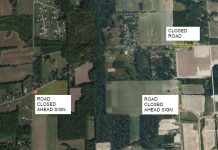
COLUMBUS — This past year was tough for most Bartholomew County farmers.
Ongoing rain during the first half of the year, followed by a dry spell toward the end of the growing season, made it difficult for farmers to plant their crops on time and, in many cases, forced farmers to replant corn and soybeans, said David Bense, a farmer who grows corn, soybeans, wheat and hay on around 1,700 acres in Bartholomew, Decatur and Shelby Counties.
Bense saw reduced, but better-than-predicted yields this year due to adverse weather conditions and — for the first time in his 37-year career as a farmer — he was forced to leave around 150 acres unplanted.
But, like many local farmers, he isn’t sure if climate change played a role in what he called a “historically rough” growing season.
[sc:text-divider text-divider-title=”Story continues below gallery” ]Click here to purchase photos from this gallery
“I think the climate goes through a cycle and who is to know where we’re at on that as far as weather patterns,” Bense said. “…I don’t think it’s anything we can do anything about. It is just the cycle of the Earth going on. I don’t know.”
According to the National Weather Service, 24.87 inches of rain fell in Bartholomew County from April 1 to June 30 — including 13.34 inches in June. The normal amount of rain expected for that three-month period is 13.92 inches.
As of Dec. 26, a total of 58.76 inches of precipitation was recorded in the county — 34% higher than normal.
Though climate scientists say it is very difficult to attribute this year’s challenging weather conditions to climate change, the conditions are largely in line with what climate models predict will be increasingly likely in Indiana as the Earth continues to warm, said Jeff Dukes, director of the Purdue Climate Change Research Center.
“We’ve likely already seen the impacts of climate change (in Indiana), and this year is a prime example of what we expect the future to look like,” Dukes said. “We had a wet spring that kept the farmers out of the fields for a long period of time, and then we had, in many parts of the state, a pretty dry end of the growing season that wasn’t helpful either. We don’t know if that is related to climate change or not, but it is consistent with the sorts of changes we expect to see in the future.”
Climate change is the long-term change in Earth’s weather patterns, according to NASA. The overwhelming worldwide scientific consensus is that climate change is being caused by human activities and will impact the entire planet in different ways, according to NASA.
Indiana, for its part, has warmed 1.2 degrees since 1895 and temperatures are projected to increase around 5 to 6 degrees by mid-century, with more warming occurring in the latter half of the century, according to the Indiana Climate Change Impacts Assessment by the Purdue Climate Change Research Center.
Increased heat and moisture are projected to, among other things, increase weed, pests and disease and decrease yields for current varieties of corn by 16% to 20% by 2050 and reduce yields of current varieties of soybeans by 9% to 11% over the same time period, the report states.
Gary Meyer, a local farmer who grows corn, soybeans and wheat, said he felt the effects of heavy rain this year, calling 2019 “one of the worst years” in his over 40 years as a farmer.
Similar to Bense and other local farmers, Meyer said the heavy rains this year were “just part of the process” and “you just deal with it.”
“I don’t really buy into the climate change thing,” Meyer said. “I do feel like there are more extremes that are happening now that didn’t 20, 30 years ago. I don’t buy into the global warming stuff.”
Dwight Smith, Bartholomew County Highway Superintendent, who farms about 120 acres of corn and soybeans, also said he had to replant crops, but climate change is not really something he thinks about.
“Personally, I haven’t thought too much about (climate change),” Smith said. “You hear about it. …You just kind of do what you can. You go through cycles when you go through dry springs and then you’ll have wet springs.”
Bartholomew County is projected to be dramatically warmer and wetter in the coming decades depending on how much action is taken around the world to combat greenhouse gas emissions.
The average number of days with high temperatures of at least 90 degrees and low temperatures of at least 68 degrees is projected to more than double by the 2050s, according to the Indiana University Environmental Resilience Institute’s Hoosier Resiliency Index, a tool that seeks to help local governments in Indiana understand the potential impacts of climate change in their communities.
In a medium emissions scenario, Bartholomew County residents are projected to see, on average, around 82 days per year high temperatures of at least 90 degrees and low temperatures of at least 68 degrees.
In a high emissions scenario, that number is estimated to climb to 95 days. The average number of such days per year in Bartholomew County from 1984 to 2013 was 35.
The Hoosier Resilience Index also projects an increase in “extreme precipitation events” in Bartholomew County, or the number of days per decade with daily precipitation of at least 2 inches. Bartholomew County could expect to see around 21 such days per decade by mid-century, compared to the average of 16 per decade from 1971 to 2000.
“The southern part of the state is probably going to get hit first,” Dukes said. “Southern Indiana is where you’re going to see conditions passing certain heat thresholds even sooner. So if you’re worried about a month’s worth of 95-degree days per year, that’s going to happen a lot faster in Evansville than it does in Gary.
For Cora Carter, agriculture, natural resources and community development extension educator at the Bartholomew County Purdue Extension, climate change could result in more difficult years for local farmers in the future.
“The main thing is that it’s going to be important to impress upon farmers that we’ve not been having a strange year,” she said. “We’ve been having one of our new years. We’re going to continue to have difficult years in the future if we don’t change things.”
Bense said he has noticed a trend over the past few years that the amount of time that local farmers have to plant their crops appears to be getting shorter.
“It seems like the last three or four years, it’s been harder and harder to get things planted on time,” Bense said. “We don’t have the window of opportunity to plant our crops that we used to.”
“We used to start planting in late April and plant until about the end of May. Now we’re lucky if we get two weeks,” he added.
Many farmers, including Bense, are already laying out plans for how they will speed up the planting process next year — including potentially purchasing additional equipment.
Carter said people will likely feel the effects of climate change, even if they don’t describe the effects as climate change.
“There are people that if you ask them straight out would say, ‘No, climate change doesn’t exist,’ or at least that it’s not man-made. Those are people who are still being affected by climate change,” she said. “…We had torrential downpours for months in the spring and that affected farmers. That affected their ability to plant their crops and some farmers simply weren’t able to plant their crops at all. They certainly have to be seeing the effects of climate change even if they aren’t recognizing what they are.”
[sc:pullout-title pullout-title=”Climate change in Indiana” ][sc:pullout-text-begin]
Visit hri.eri.iu.edu for more information about the Hoosier Resiliency Index.
Visit ag.purdue.edu/indianaclimate/ for more information about the Purdue University Indiana Climate Change Impact Assessment.
[sc:pullout-text-end]




